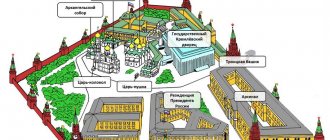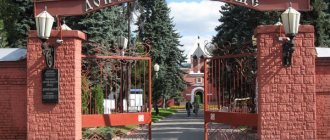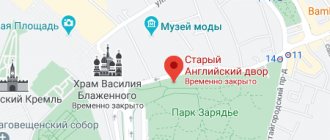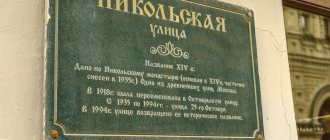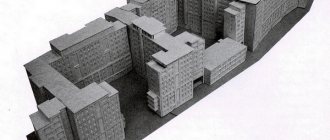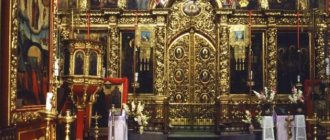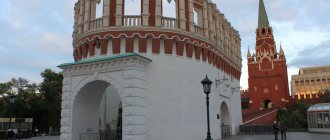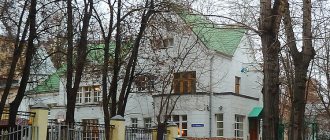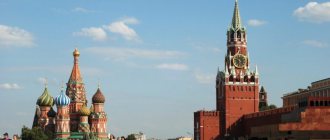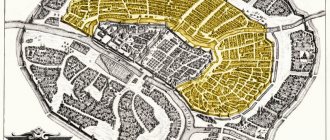Why are the battlements of the Kremlin wall shaped like a dovetail?
The Moscow Kremlin is a recognized symbol of Moscow and Russia; the silhouettes of its towers and walls are known throughout the world. And, of course, every Muscovite is well aware of the battlements of the Kremlin wall, which also became a symbol of the city - being vaguely similar to the letter “M”, they began to be mercilessly exploited in souvenirs, badges, logos and a large number of paraphernalia related to tourism and history.
A merlon (merlon) is a protrusion in the upper part of the fortress wall, which serves to cover the fortress defenders from shelling. A row of battlements with equal gaps, crowning the fortress wall, allows soldiers to fire at the enemy through loopholes in the battlements or the gap between them. The teeth come in various shapes: rectangular, pointed, round and the so-called “dovetail” - a rectangular base with a top forked from the middle. The battlements of the Kremlin wall are shaped like a “swallowtail”, which is why many believe that this design of the battlements is a purely Moscow find, however, this is not at all the case: exactly the same battlements can be found on the walls of more ancient European castles and buildings, especially in Italy ( Sforza Castle in Milan, Castelvecchio in Verona, Sirmione Castle, Arsenal in Venice and others). In general, dovetail crenellations are a characteristic feature of Italian architecture.
The fact is that the modern walls and towers of the Kremlin were built in 1485-1495 under the leadership of Italian architects: Pietro Antonio Solari, Aleviz Fryazin (Old), Marco Ruffo, Antonio Gilardi - it was thanks to them that the “Italian” battlements appeared on the Kremlin wall.
The meaning of the dovetail shape
Many are convinced that this shape of the teeth is of practical importance in defense: supposedly the gap in the fork could be used as a support for firearms and shooting, however, in reality, the likelihood of such use of the teeth tends to zero - their height is 2-2.5 meters, and shooting “through the tail” is physically impossible. For shooting, loopholes were provided in the battlements.
In fact, the dovetail is simply a decorative element that visually facilitates the completion of the fortress walls.
Such battlements first appeared in Italy in the 12th century, when a confrontation broke out in the country between the Guelphs - supporters of the Pope who recognized the supremacy of spiritual power over secular power - and the Ghibellines, who were committed to imperial power. The conflict between the factions was quite fierce, and in order to visually distinguish the fortresses, they built them with different battlements: the Guelph castles were rectangular, while the Ghibellines preferred the dovetail. It is believed that the forked shape of the battlements symbolized the double-headed eagle - the coat of arms of the Holy Roman Empire.
There is a historical anecdote that the architects, having arrived in Moscow, decided that the local prince was certainly not for the Pope - that’s why battlements in the spirit of the Ghibellines appeared on the walls of the Kremlin. But in reality, the Italians’ motivation is not so obvious, and today it is impossible to say exactly why they preferred the “dovetail” to the usual rectangular teeth, whether there was some kind of political subtext in this or whether the architects were guided by purely decorative tastes.
LiveInternetLiveInternet
Continuation. Start here Dovetail - a type of fortress tooth with a fork in the upper part. The shape of the teeth is with a pointed bifurcation of the top from the middle to the sides. Terms of Russian architectural heritage.
The famous battlements of the Kremlin wall 1045 two-horned dovetail teeth, 2–2.5 m high and 65–70 cm thick, decorate the Kremlin wall
Pay attention to the wall. Do you see the fortress battlements - the dovetail? Doesn't remind you of anything? That's right - one to one - the Kremlin wall. In the XIV century. A type of urban residential palazzo is being formed in its main features. City fortifications remain important, as before. Fortress construction is being intensively carried out in Florence, Pisa, Lucca, Pistoia and other cities, whose economic and political interests are increasingly colliding. Previously, the fortified city defended itself from the attack of the feudal lord, now - from the neighboring rival city. The fortification technique becomes noticeably more complicated. For the first time, gunshot loopholes appear, changing the shape of the fortress battlements (dovetail).
Verona/Italy
Towers of the Tula Kremlin
Arches of the southwestern wall of the Tula Kremlin. late XV - early XVI centuries.
The battlements of the south-eastern wall of the Ivangorod fortress in 1492. There is an opinion that in the defense of “cities” the battlements in the form of a swallowtail were of practical importance: their saddles supposedly served as a support for hand-held firearms. Meanwhile, it was indicated above that the saddles of the battlements of the walls of the Zaraisk Kremlin have a semicircular filling, and it could not serve as a support for weapons. In addition, from the level of the battle course of the walls, the saddles of the two-horned teeth are raised quite high everywhere. In the Tula Kremlin, for example, they are at a height of 2.5 m. This is also typical for other defensive structures, the teeth of which have a horned end. Consequently, the weapon did not rest on the prongs; in order to do this, the defenders of the “cities” would have to arrange for themselves some rather high platforms on the fortress walls, which, of course, never happened, since they would be inconvenient and would interfere with free movement along the walls. Shooting from the walls was carried out, as a rule, either through the loopholes of the battlements, or through the gaps between the battlements.
Novgorod Kremlin. The walls are completed by double-horned battlements in the form of a “swallow’s tail” placed on the parapet. Such teeth began to appear at the end of the 15th century. belonging to all Russian fortresses, symbolizing the unity of Russian lands.
Wall of the Smolensk Kremlin For centuries, the battlements of the Ghibellines, who gave their lives for the struggle against the supremacy of the church, have been looking at us from the Kremlin walls. Since the 12th century, Italy was occupied by a war between the Guelphs, supporters of the Pope, and the Ghibellines, supporters of the German emperor. Companions of both sides did not spare either their own or others’ blood. The massacre calmed down only by the 15th century. During the confrontation, both of them managed to build a lot of things in Europe. Guelph and Ghibelline castles differed in the shape of the battlements (merlons) on the fortress walls. The dovetail-shaped battlements were a sign that the owner of the castle belonged to the Ghibellines. (It is believed that this shape of the teeth represents the flapping of the wings of an eagle, which was the imperial coat of arms). The Guelphs preferred to build walls with square or rectangular battlements, more like the Pope's headdress. In the second half of the 15th century, Moscow became the political and cultural center of a unified Russian state. At the same time, the reconstruction of the Moscow Kremlin began with the participation of Italian architects. In 1485-1495, Italian craftsmen erected new walls and towers of the Kremlin, and foreign travelers often began to call it a castle. Indeed, the shape of the towers and the crown, the battlements crowning the walls are reminiscent of the Scaliger Castle in Verona and the famous Sforza Castle in Milan. When Italian architects built the Moscow Kremlin, they chose Ghibelline battlements for the fortress of the Grand Duke of Moscow, correctly believing that both the papacy and the priority of the church in general were contraindicated for Rus'. Since then, dovetail-shaped teeth have become very popular with Russian architects, who began to widely use them in fortress architecture. For example, in the fortresses of Kitay-Gorod and the Novodevichy Convent.
Sforzes Castle (Castello Sforzesco). Italy. Milan Castello Sforzesco or Castello Sforza is one of the most interesting historical monuments of Milan, and is a kind of prototype of the Kremlin.
The medieval-looking fortress, which is called the Sforza Castle, is a structure with a long history. In its place between 1360 and 1370. Visconti Castle was built and subsequently expanded. After the gate in the adjacent city wall, it was called the castle at the Gate of Jupiter. Here Bernabo Visconti, who was deposed by his own nephew, was imprisoned and died. Construction of the Sforza Castle began under Francesco Sforza, who seized power in Milan in 1450.
Visconti Castle, Locarno (Castello Visconteo), Switzerland In the Middle Ages, a Milanese family settled here, which perpetuated its name, including in one of the main attractions of the city. True, the first version of the structure was erected long before them, in the 12th century.
The construction of the castle in Sirmione was begun in 1277 by Lord Mastino (Mastino I della Scala) from the Scaligeri family (Scaligeri, from de Scalis or della Scala) as a military stronghold. Placed inside the ancient walls that surrounded the medieval settlement, but due to its noble forms it is deservedly the most beautiful castle of the Scaligerian era.
Fenis Castle. Italy In fact, the first evidence of Castrum Fenitii dates back to the beginning of the 13th century, at which time the castle belonged to the family of Viscounts D'Aosta, in fact, the castle has been part of the Challant family estate since 1242, but information about this remains very uncertain until until the beginning of the reign of Aymon de Challant in 1330. Around 1340, Aymon began modernizing the castle. The years of the reign of Eamon and his son Boniface I, from 1320 to 1420, were the most significant for the formation of the castle. They can be divided into four main phases. Boniface II, who inherited the castle from his father in 1426, managed the estate for about 50 years (until 1469). He conceived a new plan for the castle, but it was never implemented due to disputes between his sons (according to documents there were three of them). After the death of all the brothers, the castle passed to Guillaume's son, Humbert, who ruled the Fenis castle until 1513. During all this time, the castle was not restored or rebuilt, its walls became mute witnesses to the fading of the family of the founders. The Shallans owned the castle and surrounding lands until the end of the 17th century. During all this time, repair work was carried out sporadically and was insignificant.
Coira Castle - Sludern, Tyrol. Italy
Montebello Castle. Switzerland Built probably at the end of the 13th century. Belonged to the Rusca family from Como
Castello de Albertis Built between 1886 and 1892 under the direction of Alfredo D'Andradi, the castle is located within the 16th century city walls. This was the first Castle Villa built in Genoa.
Imperial Castle (Castello dell'Imperatore e Cassero) The Imperial Castle in Prato is the only example of Swabian architecture in north-central Italy. The citadel was built by the Sicilian architect Riccardo da Lentini in 1237-48 by order of Emperor Frederick II. Presumably, the death of Frederick II (1250) did not allow the completion of the construction of the interior premises and buildings. Served as headquarters for local Ghibellines
Bodrum Castle. Turkey For the first time we find mention of Halicarnassus (the place where the current city of Bodrum is located) in Herodotus... He reports that Halicarnassus was founded by the Greeks of the Dorian tribe, people from Troezen, located in the western Peloponnese in Argolis. It is unknown when this happened - probably during the era of the great Greek colonization, which began in the 8th century. BC e. There are also references to the fact that Helicarnassus previously had the name Zephyria. The city acquired this name (Zephyria) from its location on a narrow isthmus called Zephyrium, which separated the peninsula from the mainland of Asia Minor.
Castle on the island of Rhodes. Greece The Island of Roses (or Rhodes Island) was a famous and popular city in the Middle East. It is known primarily for the Colossus of Rhodes, but unlike the Colossus, the Castle of Rhodes has survived to this day. And, of course, there is no end to tourists. The castle itself, built in the 13th century, has 205 rooms and a central chamber where councils were held. Largely thanks to this castle, Rhodes is now a prosperous city, in which more than forty thousand people work for the benefit of tourists. “In the Voynich manuscript there is only one realistic image of the city, which shows a fortress wall with dovetail battlements. At the beginning of the 15th century, such teeth were found only in Northern Italy (later they became more common).”
Symbol and rune M
https://www.russiancity.ru/books/b78c.htm https://forum.autoua.net/showflat.php?Cat=0&Num…;page=7&fpart=all&vc=1 https://ru-italia.livejournal .com/1389843.html
What are the battlements on the Kremlin wall called?
The battlements on the Kremlin wall are called merlons, which means pier in French.
The gaps between them are loopholes. The main purpose of the teeth is defensive. They protect the personnel of the fortress defenders from shelling. The battlements on the fortresses came to Russia from Italy. During the Middle Ages, its territory was divided between two political entities, such as:
- Guelphs. They sought to strengthen the influence of the Pope. Their fortresses were decorated with square and rectangular battlements. This form is simpler and less attractive.
- Ghibellines. They advocated strengthening the power of the emperor. This association decorated the walls of the fortresses with battlements in the form of an imperial eagle. This form involved the merlons spreading from the middle to the sides.
It is worth paying attention to the fact that the construction of the Kremlin that has come down to us began under Ivan III, who specially invited an Italian architect for this purpose. Aristotle Fioravanti decided to decorate the local Kremlin with battlements, which were used by the Ghibellines (not to obey Ivan III the Pope). Over time, these decorative elements of the Kremlin began to be called swallowtails.
What are the main differences between the Orthodox, Catholic and Protestant churches?
This is a dangerous question. At a minimum, because there are too many people in each of the three faiths, and fighting will inevitably begin. But still. I have as many as 105 points, I can afford to go into the minus. Without philosophical reasoning, purely factually, according to the list, so to speak:
AHTUNG! Absolutely unbiased attitude!
- There is a triune God, the Mother of God, countless saints and martyrs. The main emphasis, oddly enough, is on the saints - they are addressed in most cases. There are different saints for different occasions, but in general, one of the Holy Trinity is addressed less often. They also pray to angels.
- Icons, relics
- Canonical prayers and chants
- Long hierarchical chain (I don’t know what else to call it. I’m trying to convey the essence and not be “politically correct”)
- There is no world leader. I mean, Patriarch Kirill is the head of the Orthodox Church in Russia (comment 2: and Belarus, but not Bulgaria)
- General, so to speak, calendar participles, and, as far as I remember, there are not so many of them. But you can take communion every day.
- Clearly regulated worship services (point “A” is always followed by point “B”, and it is always the same). Naturally, there are several “regulations” for different circumstances.
- Language - Old Church Slavonic or Old Russian. I'm always confused. To some extent, even close to Old Bulgarian.
- Now you don’t need to yell at me and throw slippers at me, because it’s true, and everyone knows it: 80% (I dare say, but I just don’t know how to put it another way) of the “services provided by the church” are paid. It’s free to just come in to pray (without a candle) and attend the service. Drink some water.
- The chants use ONLY the CHORUS, the “music” is ancient (you won’t believe it, but its roots go back to the Gregorian chants of the 11th century! I like to go listen sometimes. In some places in the outback (but you can count such places on one hand) they still sing non-mean recording. Naturally, the melody is even closer to the 11th century)
- For priests, this is their only “job.” I mean, they don't work anywhere else. They can do something else and take some kind of payment for it (for example, paint icons and sell them), but, for example, they cannot be directors of chocolate factories).
Catholicism: * There is a triune God and Mother of God and saints. The main emphasis is on Christ and the Mother of God. To the last one first. * There are icons, although they are more similar to paintings and are not so common. * Canonical prayers and chants * Long hierarchical chain * There is a world head (the Pope) * Communion every service, but only those who, so to speak, have completed the preparatory course can receive it. For Catholics, first communion (first communion, if I'm not mistaken) is a significant day, which is celebrated as a holiday and gifts are given. * Clearly regulated worship services. Even every remark of the priest (priest) that he speaks is regulated (unless it is a sermon) (that is, everything except the sermon is according to regulations). Naturally, there are different regulations for different circumstances. * Language - I can’t say for sure. Previously, Latin was everywhere. Now, in Belarus - Belarusian, but closer to Poland - Polish. In Poland, the native language of Poland is Polish. * Almost all services are free * In addition to the choir, instruments are used in the chants. It can only be an organ (mostly it is), or there can be other instruments (in addition to the organ). (sometimes I go to listen to the organ) * For priests this is the only “job”; for lower-ranking employees this is not necessarily the case. * Unlike other denominations named here, Catholic priests take a vow of celibacy.
Advisor to the head of the FSO revealed the secrets of the Kremlin wall
HELP "MK"
Under Prince Dmitry Donskoy in 1367, white stone walls were erected around the Kremlin instead of the previous wooden walls. Their length was almost 2 km (now 2 km 250 meters). At the same time, an additional wall was erected at the foot of the hill on the side of the Moscow River, which did not allow the enemy to create a bridgehead for deploying forces during the siege of the Kremlin. It was lower than the Kremlin, but better adapted to artillery and rifle fire. It has not survived to this day.
A walk along the Kremlin wall will be cooler than any exotic excursion. This is the very place where they won’t let you in for any money. At one time, Kremlin employees were taken to the wall, so to speak, to get acquainted with history. And today this is practiced from time to time for the “chosen ones”. But there are very, very few such lucky ones.
My guide is Advisor to the Director of the Federal Protective Service, Doctor of Historical Sciences, Professor Sergei Devyatov. The main collector and researcher of legends about the towers and walls of the Kremlin, by the way!
The New Year holidays turned out to be great, snowy and frosty. For us, going to conquer the Kremlin wall, this is generally a gift of fate. Our journey begins from the Spasskaya Tower. I torture Devyatov about the secret passage that came from it, and about the dungeons that are under it. At least that's what some historians say.
“Information about such a secret passage was found in a report by archaeologist I.Ya. Stelletsky (he examined the tower dungeon) in the NKVD of the USSR,” says Sergei Viktorovich. - I saw her. Do you know what exactly is written there? That Stelletsky is going to “go underground from the Spasskaya Tower to St. Basil’s Cathedral, near which there is a descent into a large tunnel under Red Square, a tunnel with a very mysterious purpose.” That's all. No diagrams, drawings - nothing. And there is no information about whether Stelletsky found it and walked along it in the end. We studied all his correspondence and personal documents. And again nothing. We did not find similar data in state and departmental archives. Moreover, during the restoration of St. Basil's Cathedral, the director of the State Historical Museum, Konstantin Levykin, set the task of exploring the foundations of the cathedral. No dungeons or any passages from the ancient church towards the Kremlin were found. As for the dungeons of the Spasskaya Tower, we were talking about ancient “rumors” - long underground galleries that served as secret exits beyond the walls. They were made to combat enemy undermining. “Rumors” near Spasskaya became dilapidated and crumbled in the century before last.
I look at the tower. There seems to be no entrance to it either from outside or from inside the Kremlin. But in the arched gate on the left wall I notice high hewn white stone steps leading to a massive iron door with forged hinges. This is the entrance to the lower tier of the tower. Construction cranes remain behind, dismantling the 14th building of the Kremlin. Step by step, and now we are already on the third tier. If from the side of Red Square the facade of the 14th building is still visible, and it seems that it stands unshakably, then from here a completely different picture opens: there are almost no “insides” of the building, just rubble... But this is a sad sight for those who know the history , does not cause, especially since grandiose archaeological excavations are coming at this place. There have never been anything like this in the Kremlin. And considering that the Chudov and Ascension monasteries (it is in their place that the 14th building stands) were built in the 14th century, during the era of Dmitry Donskoy, and before that there was a Golden Horde courtyard there, finds here can be completely unique and unexpected.
Meanwhile, we are inside the citadel tower. Out of the corner of my eye I try to see Red Square, but I can’t: in the lower tiers there are two walls (the second was made in case the first one collapses), and they block the view. The passage in the tower leads us to another mighty iron door. It's like it's all stitched with iron sheets. Giant loops have withstood all this power for more than five centuries. We open the door (oh that quiet creak, as if from a fairy tale!) - and go out onto the upper battle platform of the Kremlin walls.
The road along the wall in the section from the Spasskaya Tower to Beklemishevskaya is quite wide, and there are even places where you can rest. Photo: FSO of Russia.
It is quite spacious here: the passage is two meters wide. These are the same Kremlin merlons - the legendary protruding battlements with loopholes, topped with a white stone swallowtail, of which there are 1045 in total.
“The height of the two-horned battlements - merlons - that crown the walls is from 2 to 2.5 m, the thickness is 65–70 cm,” my guide approaches the loopholes and carefully shakes off the snow from them, while telling the story. — In their form, they are similar to the elements of the architectural design of the palaces of medieval Verona. But unlike the Italian “analogues”, the Kremlin ones have not only a decorative, but also a purely applied, defensive function due to the large thickness and height of the teeth. During the fighting, the archers closed the gaps between the merlons with special wooden shields and fired through narrow slit-like loopholes.
Devyatov, like a magician, pulls out a wooden panel that came from nowhere and shows how it happened. And we try to imagine how the soldiers who stood here many centuries ago felt during the siege of the Kremlin.
— While “scanning” the entire thickness of the wall, can scientists discover the remains of those killed during the defense? - I torture Devyatov.
- I'm sure not. Such a tradition - burying directly in the wall - has never existed here.
Meanwhile, I look around - the beauty is beyond words! On one side, St. Basil's Cathedral is below us, on the other, the Tainitsky Garden. And above our heads is the sky and the now New Year’s snow falling on us in large flakes.
“Please note that the height of the internal walls is lower than the external ones,” Sergei Devyatov interrupts my admiration for the view. — This is due to the difference in ground level.
It’s strange, not a single FSO officer caught our eye. But the territory is clearly inhabited. It is obvious that someone recently swept away the snow and generally keeps everything here in perfect order. Later, the FSO veterans explained to me: “The officers on the wall are constantly on duty. But as soon as you climbed the wall, they noticed you and made sure that you did not detect their presence. By the way, there is even a telephone connection there. Although they hardly use it. But these are subtleties of craftsmanship.”
— Go ahead, conquer the wall? Or is it already enough? — Devyatov clarifies, apparently mistaking my thoughtful enthusiasm for doubt.
Forward! It’s difficult to walk in places; you have to step over communication pipes. On our way there is a 16-meter tiny tower that doesn’t even have a foundation - the Tsarskaya. Let's pass it.
Devyatov says that the height of the walls of the Moscow Kremlin varies from 6.5 to 19 meters. It was determined by architects and fortification (defensive structures) specialists.
— It depended on the terrain, the presence of more or less serious water barriers and the degree of threat of attack from one side or another of the fortress. By the way, the thickness of the walls for the same reasons varies from 3.5 to 6.5 meters.
And we are already approaching the Moskvoretskaya, or, in other words, the Beklemishevskaya tower, located on the south-eastern corner of the Kremlin. Perhaps it is the most elegant - its outline resembles a slender eastern minaret. In addition to its defensive purpose (it was supposed to repel the attacks of the Golden Horde), the tower was at times used as a prison for especially dangerous persons. Thus, in the 15th century, the Venetian ambassador was imprisoned here, who was convicted of deceiving the Russian sovereign. State criminals and rebellious boyars were also interrogated here. By the way, the boyar Beklemishev himself, in whose honor the tower was named, was kept prisoner here by Prince Vasily III for his “arrogance.” But you won’t see anything “bloody” here now. The tower breathes beauty and sophistication. And from its upper tier, from under its tent, a wonderful view of Ivanovskaya Square opens up!
View of St. Basil's Cathedral from the height of the Kremlin wall. Photo: FSO of Russia.
Go ahead. I soon realize that something has changed. But what exactly? It turned out that before we were walking along the ancient masonry of the wall, and now we were walking along the “young” one. In the 18th century, two walls facing the Moscow River were partially dismantled by the architect Vasily Bazhenov (they were later restored). But on whose orders? Catherine the Great, herself! Legends don't lie. But this is what happened: the old fold began to crumble, and the residents tried to pull the wall brick by brick into their own houses. And Catherine conceived a grandiose reconstruction, which she entrusted to Bazhenov. The idea was this: on the southern side of the Kremlin there would be a new ceremonial palace, the huge staircase of which would descend directly to the Moscow River. That's why the wall was broken. But during the digging of the foundation pit, the most ancient Kremlin cathedrals became askew. Catherine the Great considered this a bad sign and ordered everything to be restored to its original form.
I look from the height of the restored southern wall at that part of the Taynitsky Garden that is usually not visible. Below is someone's small house.
“This is an enclosure for our eagle owl,” explains Devyatov. “He's not just here for effect. On duty - protecting the Kremlin from crows.
MK was the first to write about the eagle owl Filya and his appearance at the presidential residence. But only now it became known that an incident had arisen: Filya turned out to be... a girl. Kremlin ornithologists don’t know how to call him now.
- Let's call him, that is, her, Filicia? — I propose to Devyatov. He approves and promises to convey MK’s proposal to the ornithological service. Filicia, meanwhile, flaps her huge wings and soars into the sky. To us? I hope we don't look like crows and she won't have to attack us. But seriously, the owl does not pose a danger to people: he was trained by the best experts in the country, and he feels real reverence for people, like a person before God.
While we were watching the eagle owl, it began to get dark. It's time to talk about mysticism.
I ask Devyatov to tell “horror stories” about the Kremlin wall. Well, for example, about how Ivan the Terrible repented of his mortal sins here.
“He repented before the people at the Place of Execution, and before God in the temple,” says Devyatov. “But the wall has been a mysterious place since his time thanks to the multiple secret passages that went along and through it. Plus secret rooms (we found very tiny ones where a person can only sit). I remembered one funny, but not scary story. In the 19th century, before the arrival of the Emperor, an ancient bronze cannon disappeared from the Kremlin wall. The scandal threatened to break out big. The Moscow chief of police gathered the top of the Moscow criminal world and warned that in a day the cannon should lie at the foot of the Konstantin-Eleninsky tower. Indeed, in the morning the gun was found in the designated place. But after the emperor’s departure, it turned out that it was stolen from another Kremlin tower - Tainitskaya. The first one was never found...
On the way to the Vodovzvodnaya Tower you come across many spotlights that illuminate the Kremlin. Photo: FSO of Russia.
On the way to the Vodovzvodnaya Tower we meet... no, not people, but all kinds of devices, spotlights (thanks to them, today the Kremlin is illuminated like no other object in Moscow). In some places you can even sit down - someone has built some kind of benches. And now we enter the tower, the exclusivity of which was recognized even by Joseph Stalin.
“This recognition was somewhat specific, but quite definite,” says Devyatov. — In the mid-1930s, golden imperial eagles were dismantled from the Kremlin towers. The Vodovzvodnaya Tower was always crowned with a gilded weather vane, but it was the only tower that was chosen in Soviet times to replace the weather vane with a ruby star. At first glance, there were no ideological reasons for such a replacement. But it is worth keeping in mind that Stalin very accurately, on an intuitive level, felt how this or that object could be used for propaganda. Of all the Kremlin towers, from the point of view of the Secretary General, this one was suitable for this purpose - the corner Vodovzvodnaya Tower. And she received a ruby star as a decoration. After this, the height of the tower with the star reached almost 62 meters. It is worth noting that after this Soviet modification, the unique beauty of this tower did not suffer at all, and the huge ruby top only emphasizes its slenderness and even some visual fragility.
Alas, the tower is not suitable for life. In general, today only Troitskaya is inhabited (the presidential orchestra rehearses there). All the rest are cold, there is not only heating, but also running water, and there is no way to use them in any way. Although in ancient times state archives were kept in some of them.
We walked a total of a little more than 1 km 200 meters. We descended from the wall near the ancient Borovitskaya Tower when the stars had already “lit up” in the sky, against the background of which the Kremlin rubies burned even brighter.
The whole journey took almost two hours, taking into account the fact that we were in no hurry and stopped constantly. It's not that much. I’m calculating... It turns out that to run around the entire wall (which, let me remind you, is more than two kilometers), just 15 minutes is enough! True, this will be an obstacle course - the runner will have to jump over pipes and other obstacles.
The ancient Kremlin has already presented us with a lot of surprises in recent years (just look at the icons found in the towers and the treasure of ancient coins underground). But, apparently, the time to be surprised has not yet passed. The coming months will certainly bring new discoveries from the ancient history of the Kremlin. After all, the battlements can not only defend, but also surprise...
